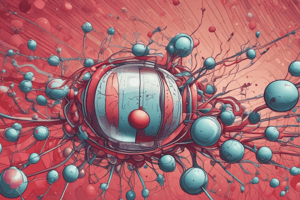Podcast
Questions and Answers
What is the main component of heparin?
What is the main component of heparin?
- Sulfated D-glucosamine (correct)
- Unsulfated D-glucosamine
- Mucopolysaccharide
- D-glucosamine
Which of the following is NOT a source of heparin?
Which of the following is NOT a source of heparin?
- Intestinal mucosa
- Livers
- Lungs
- Fish skin (correct)
What is the primary function of heparin as an anticoagulant?
What is the primary function of heparin as an anticoagulant?
- To prevent the formation of blood clots (correct)
- To break down formed blood clots
- To dissolve blood clots
- To form blood clots
What type of molecule is heparin classified as?
What type of molecule is heparin classified as?
What is the resulting effect of heparin on blood clots?
What is the resulting effect of heparin on blood clots?
What happens when heparin is mixed with alkalies?
What happens when heparin is mixed with alkalies?
What is the effect of acids on heparin?
What is the effect of acids on heparin?
Which of the following can be used to precipitate heparin?
Which of the following can be used to precipitate heparin?
What type of salt is formed when heparin reacts with Cadmium?
What type of salt is formed when heparin reacts with Cadmium?
What happens when heparin reacts with Barium?
What happens when heparin reacts with Barium?
Study Notes
Heparin Structure and Composition
- Heparin is a complex organic acid and a mucopolysaccharide
- Composed of sulfated D-glucosamine
Source of Heparin
- Obtained from the livers, lungs, and intestinal mucosa of domestic mammals
- Sourced from animals used for food by humans
Uses of Heparin
Anticoagulant Properties
- Prevents the formation of blood clots
- Helps in the normal breakdown of formed blood clots
Studying That Suits You
Use AI to generate personalized quizzes and flashcards to suit your learning preferences.
Description
This quiz covers the structure and composition of heparin, a complex organic acid, and its uses as an anticoagulant to prevent blood clot formation and aid in their breakdown.




